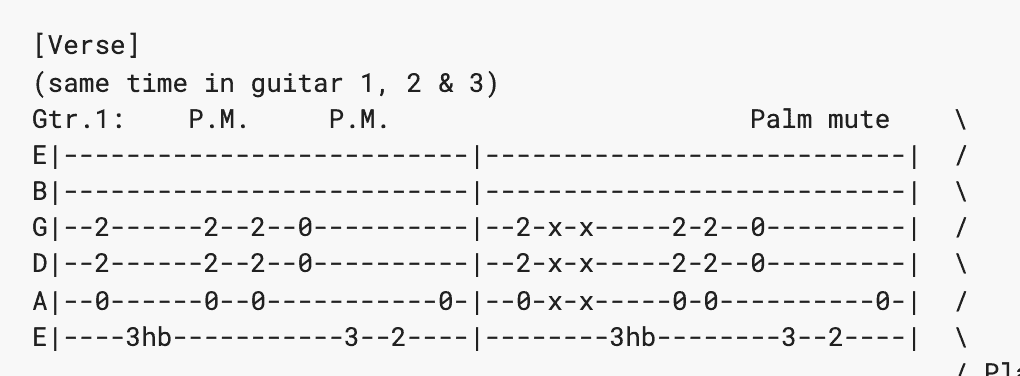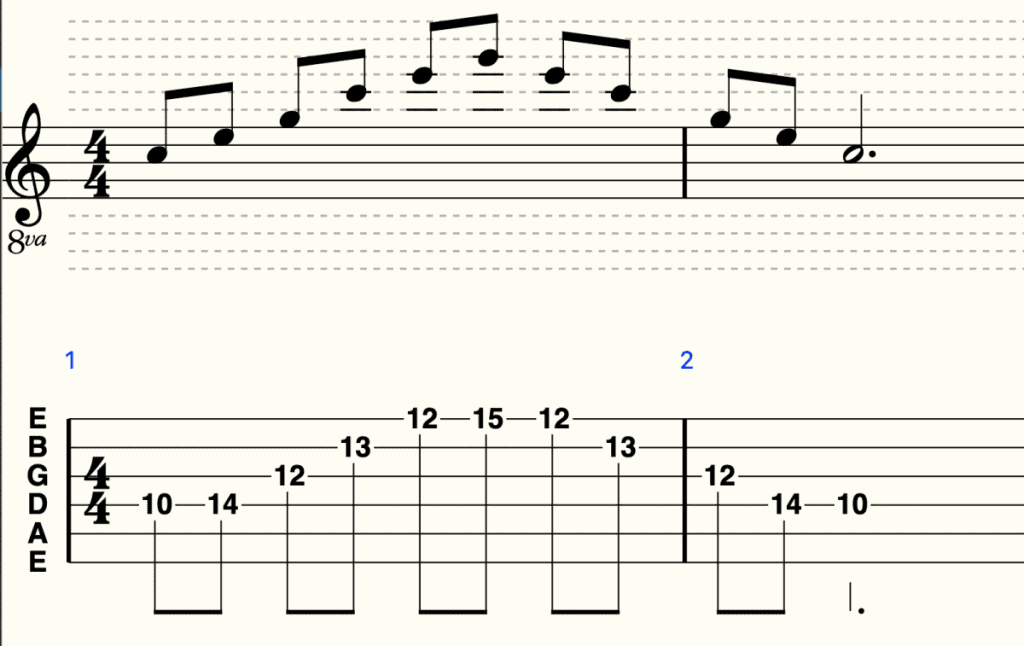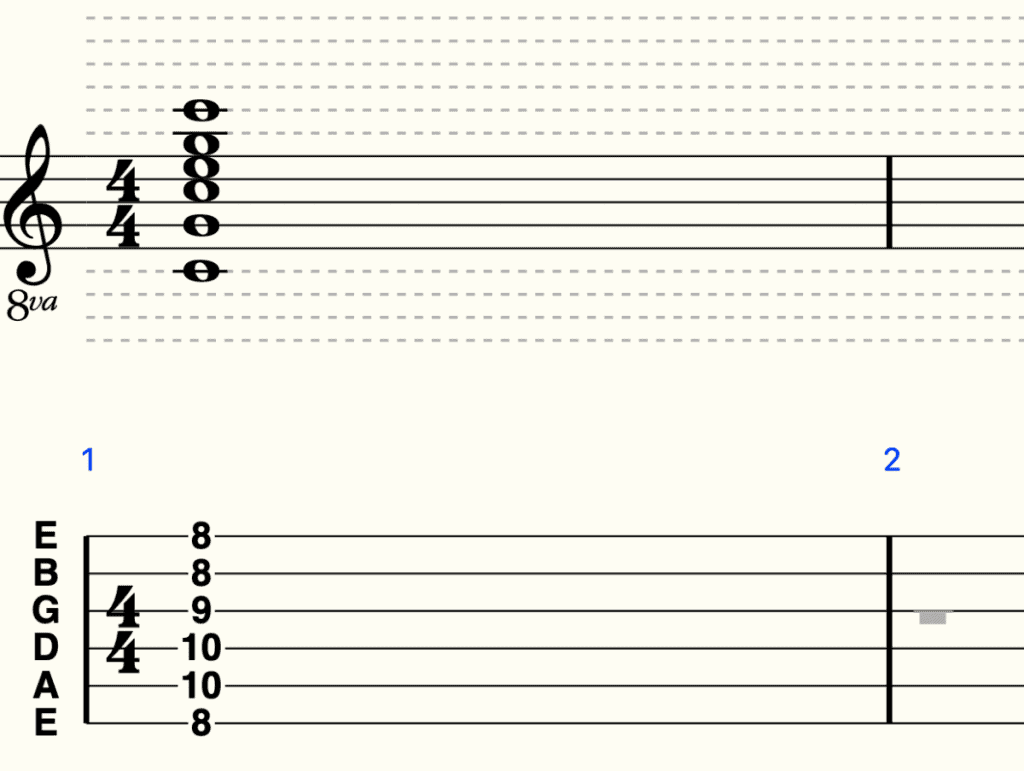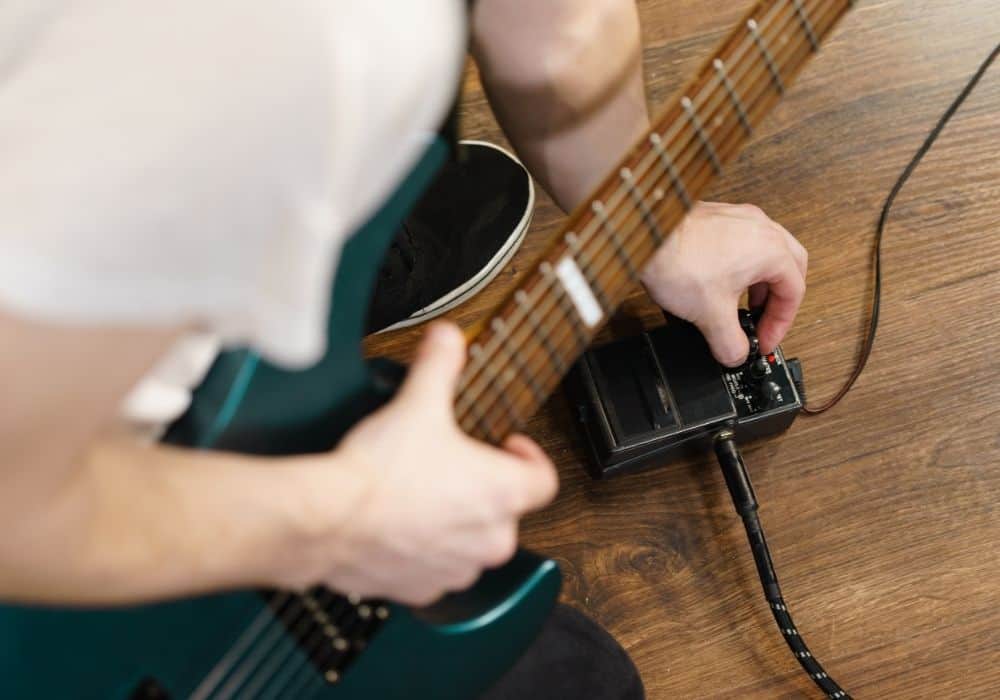Anyone who is new to guitar playing may wonder what the difference is between a lead and a rhythm guitarist. While both guitar players can interchangeably switch positions between lead and rhythm, the two styles serve entirely different purposes.
A lead guitarist usually performs the song’s melodies, solos, fills, and various embellishments that add style and complexity to the track. This role contrasts with that of the rhythm guitarist, who typically provides the rhythmic and structural foundation of the song.
A great way of illustrating the primary difference between the two lies in who plays the chords and who plays the melodies over top of the chords. Explained in another way, the lead guitarist often plays melodies in the musical context set by the rhythm guitarist.
During the formation stage of the creation of a band, it’s commonly assumed that the guitar player who is better at playing melodies, whether fast or slow, will be the one who plays lead. Whereas the rhythm guitarist will be the player who is more comfortable playing the chords, lines, and musical passages that set up the foundation of the track.
What Do Lead Guitar Players Do?
Typically, lead guitar players can be distinguished by rhythm guitarists simply by looking at what types of musical passages they use in their parts. First and foremost, are the guitar solos.
1) Guitar Solos
While rhythm guitarists also play guitar solos, such as Dave Mustaine in Megadeth, for instance, usually this duty is left up to the lead guitarist. Chances are, if the guitarist is the one playing all the solos, that makes them the lead player, but not always.
For instance, while Dave Mustaine might play guitar solos as well, in Megadeth’s discography, there’s no question that Marty Friedman was the lead player during his time in the band. His solos were amazing, by the way, especially on Countdown to Extinction.
As another example, you can compare Mike McCready to Stone Gossard in the band, Pearl Jam.
Mike is the lead player, and Stone Gossard is the rhythm guitarist.
Or in the case of Guns and Roses, Slash was the lead player and Izzy Stradlin was the rhythm guitarist.
Another great example of the differences between lead guitarists and rhythm guitarists in the band, Metallica, with Kirk Hammett acting as the lead player and James Hetfield acting as the rhythm guitarist.
Kirk Hammett almost always played the solos in the band, with the exception of a few songs.
The clearest example of this was on their first record, Kill’Em’All, which clearly was Kirk’s time to shine in terms of guitar solos.
That album has so many awesome bluesy guitar solos that were handled almost entirely by Kirk.
You can easily distinguish between the lead and rhythm guitarist based on which guitarist is playing the guitar solos and which guitarist is playing more single-note musical passages versus a guitar riff which utilizes a lot more chords and power chords.
This brings me to my next point.
2) Single-Note Passages
As I just mentioned, lead guitarists typically have a lot more single-note passages than rhythm guitarists. You can see this example in the song, “Welcome To The Jungle,” from Guns and Roses, particularly in the first few bars of the song.
For instance, in that classic 1987 song, Slash starts out with the descending pentatonic riff which uses a lot of reverb and delay, and Izzy Stradlin plays the chords underneath it which act as the musical context in which Slash is playing.
You can see this example again during the main riff of the song, where the two guitar players are playing essentially the same riff, although, the difference between the two is readily apparent at the end of the passage.
You can what this looks like in the guitar tablature below:
Slash’s part:


As you can see, there is a passage that Slash plays in which he descends down the Blues scale. This is an example of more stylized single-note passages that characterize the lead guitar player’s role in the band.
Now compare and contrast that to Izzy Stradlin’s part:

The two riffs are fundamentally the same, however, Izzy’s part is far less complicated and there aren’t as many single-note passages. He just plays an “A” note on the high E-string as a way of adding a bit more musical context.
I’d say the clearest example of a lead guitar part is in the song, “Sweet Child O’ Mine” from Guns and Roses.
It features arguably one of the greatest lead guitar parts in the history of rock music, and it’s instantly recognizable as Sweet Child’ O Mine.
Slash handles that part, and then Izzy Stradlin provides the musical context in which Slash plays the now-iconic riff.
3) Arpeggios
Another great way to distinguish between a lead guitar player and a rhythm guitar player is the use of arpeggios.
An arpeggio is an Italian term that comes from, “arpeggiare,” and it means to play on the harp.
The harp was typically used to play the leads in a song back in the day, so we still use the term today although the meaning of the term has shifted a little bit.
An arpeggio, in modern times, means we’re playing the notes of the chord often quickly in single-note fashion rather than as one chord.
For instance, you can play the C Major Chord harmonically, which means we’re playing all of the notes at once.
However, if we arpeggiate the C Major chord, you play all of the notes in succession one after another rather than at once.
Here’s what a C Major Arpeggios looks like on the guitar:

Compare and contrast the C Major Arpeggio to the C Major Chord, which looks more like this:

You can see arpeggios and chords in the context of the differences between rhythm and lead playing all over music, but especially in metal and rock.
For instance, the first example that comes to mind is the band, Protest The Hero.
Luke Hoskin is the lead guitarist and Tim Millar is the rhythm guitarist.
In this particular case, Luke Hoskin typically plays more of the tapped arpeggios and stylized single-note passages in comparison to Tim, who will usually use more Jazzy chords and power chords.
Protest The Hero is a great example of the differences between lead and rhythm guitar playing because Luke is almost always the one to play all of the tapped sections and arpeggios.
4) Use Of Effects

A rhythm guitarist can definitely use effects in the same way that a lead guitar player can. For instance, there are countless songs where a chorus, flanger, or phaser is used on the rhythm section of the song.
While a rhythm guitarist uses effects as well, so does a lead player. I would argue that it’s more common for lead players to use way more effects, particularly on guitar solos.
On “Sweet Child’O’Mine” for instance, Slash used a lot of wah-wah on his guitar solo in that song. Some people describe it as one of the best solos of all time.
Using the example of Kirk Hammett again, there’s no question that he was the one to use the most wah-wah. I imagine you could find a song or two where James Hetfield also used wah-wah, but it was mostly Kirk.
Exceptions And Important Things To Note
Unclear Division Between Rhythm and Lead Guitar Playing
Truthfully, there can be an unclear division between lead and rhythm guitarists.
Using the example I touched on above, Dave Mustaine and Marty Friedman from Megadeth are an illustration of this phenomenon.
Mustaine often played guitar solos in Megadeth the same way that Marty Friedman did, but it was more common for Marty to take on this role.
This is because Dave Mustaine already played as a lead guitarist in another band, Metallica, before he moved on to his own band.
The two guitar players can often trade roles, with each one switching to Rhythm and Lead, depending on how they’re feeling at the time.
The lead guitar player can play a solo while the rhythm guitarist provides the musical context.
And then they can switch, with the rhythm guitarist then playing the lead role while the formerly leading guitarist plays the rhythm section which provides musical context to the song.
Lead And Rhythm At Once
In other cases, there can actually be a guitar player in a band who performs both the rhythm and lead section in a band.
One of the greatest examples of this is the guitar player, The Edge, in the band, U2.
In that band, The Edge is not only the lead guitarist who establishes the melody of the song, but he plays the rhythm section as well.
The Edge is often renowned for his use of effects, which he uses on almost every song.
Another similar player is Tom Morello from Rage Against The Machine, who used a lot of effects as well and also played the rhythm and lead in the band.
Other Articles You May Be Interested In
YouTube Video Tutorial
Conclusion
Keep in mind that rhythm guitarists can do all of the same things as a lead player. A rhythm guitarist can play guitar solos, use effects, play single-note passages, and arpeggios as well.
What separates the two styles is the fundamental purpose.
All-in-all, the fundamental purpose of the lead guitar player is to establish the melody of a piece of music or stylize a pre-existing melody, to fill it out more, or to make it more interesting.
For the most part, the rhythm guitarist, bassist, and other instrumentalists in the band provide the structure, the backbone, or the musical context in which the lead guitarist plays.

 Written By :
Written By :